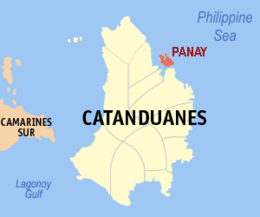
Panay is the sixth-largest and fourth-most populous island in the Philippines, with a total land area of 12,011 km2 (4,637 sq mi) and a total population of 4,542,926, as of 2020 census. Panay comprises 4.4 percent of the entire population of the country. The City of Iloilo is its largest settlement with a total population of 457,626 inhabitants, as of 2020 census.

Catanduanes, officially the Province of Catanduanes, is an island province located in the Bicol Region of Luzon in the Philippines. It is the 12th-largest island in the Philippines, and lies to the east of Camarines Sur, across the Maqueda Channel. Its capital is Virac, the most populous town in the province. It had a population of 271,879 people as of the 2020 census.
The Philippine archipelago is one of the world's great reservoirs of biodiversity and endemism. The archipelago includes over 7000 islands, and a total land area of 300,780 km2.
The Central Philippine languages are the most geographically widespread demonstrated group of languages in the Philippines, being spoken in southern Luzon, Visayas, Mindanao, and Sulu. They are also the most populous, including Tagalog, Bikol, and the major Visayan languages Cebuano, Hiligaynon, Waray, Kinaray-a, and Tausug, with some forty languages all together.

Bagamanoc, officially the Municipality of Bagamanoc, is a 5th class municipality in the province of Catanduanes, Philippines. According to the 2020 census, it has a population of 11,086 people.

Panganiban, officially the Municipality of Panganiban, is a 5th class municipality in the province of Catanduanes, Philippines. According to the 2020 census, it has a population of 9,713 people.
Panay is the sixth-largest and fourth-most populous island in the Philippines.

Virac Airport is an airport serving the island province of Catanduanes in the Philippines. It is located in the capital, Virac. It is the only airport in the province of Catanduanes.
The legislative districts of Albay are the representations of the province of Albay in the various national legislatures of the Philippines. The province is currently represented in the lower house of the Congress of the Philippines through its first and second, and third congressional districts.

The blue-backed parrot, also known as Müller's parrot is a large, endangered species of parrot endemic to the Philippines. It is found in tropical moist lowland forest but is now feared locally extinct in a large part of its range including Negros, Panay, Leyte, Luzon and Polilio. It now recently seen in Samar, Mindanao and Tawi-tawi. Flocks are small and often active at night. Its main threats are habitat loss and trapping for the pet trade.
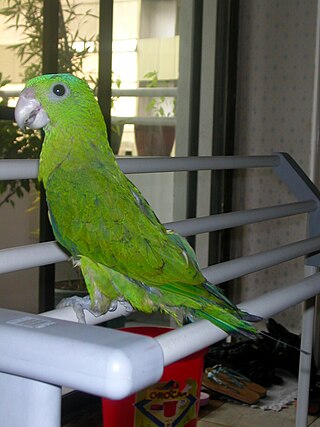
The blue-crowned racket-tail is a parrot found on all the larger islands of the Philippines except Palawan and Panay islands. It is 27 cm, basically green with a blue crown, bluish undertail, whitish beak, and dark underwings with green coverts. The blue-headed racket-tail was formerly included in this species.
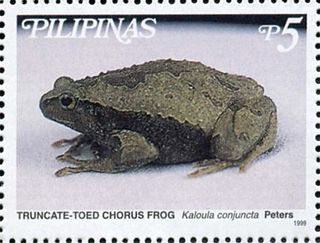
The Philippine narrowmouth toad or the truncate-toed chorus frog is a species of frog in the family Microhylidae. It is endemic to the Philippines. Its natural habitats are subtropical or tropical dry forests, subtropical or tropical moist lowland forests, subtropical or tropical moist shrubland, subtropical or tropical seasonally wet or flooded lowland grassland, rivers, intermittent rivers, freshwater lakes, intermittent freshwater lakes, freshwater marshes, intermittent freshwater marshes, arable land, pastureland, plantations, rural gardens, heavily degraded former forest, water storage areas, ponds, irrigated land, and seasonally flooded agricultural land. It is threatened by habitat loss.
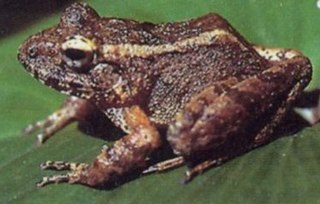
Platymantis dorsalis is a species of frog in the family Ceratobatrachidae. It is endemic to the northern and central Philippines. Its natural habitats are subtropical or tropical moist lowland forests, subtropical or tropical moist montane forests, plantations, rural gardens, and heavily degraded former forests. It is threatened by habitat loss.

The Philippine hawk-owl is a species complex of owls in the genus Ninox. They are all endemic to the Philippines.

The amethyst brown dove is a species of bird in the family Columbidae.
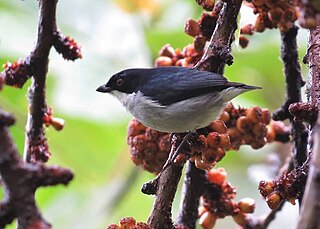
The bicolored flowerpecker is a species of bird in the family Dicaeidae. It is endemic to the Philippines.

Trimeresurus flavomaculatus is a venomous pit viper species endemic to the Philippines. Two subspecies are currently recognized, including the nominate subspecies described here.
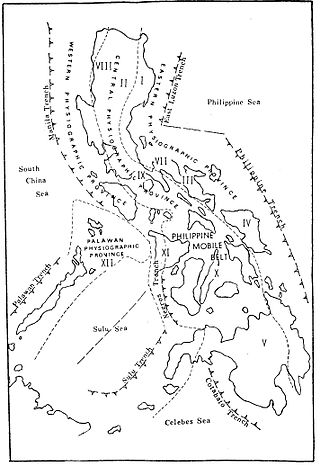
In the geology of the Philippines, the Philippine Mobile Belt is a complex portion of the tectonic boundary between the Eurasian Plate and the Philippine Sea Plate, comprising most of the country of the Philippines. It includes two subduction zones, the Manila Trench to the west and the Philippine Trench to the east, as well as the Philippine Fault System. Within the Belt, a number of crustal blocks or microplates which have been shorn off the adjoining major plates are undergoing massive deformation.

The Bikol languages or Bicolano languages are a group of Central Philippine languages spoken mostly in the Bicol Peninsula in the southeastern part of Luzon, the neighboring island-province of Catanduanes, and the island of Burias in Masbate.
